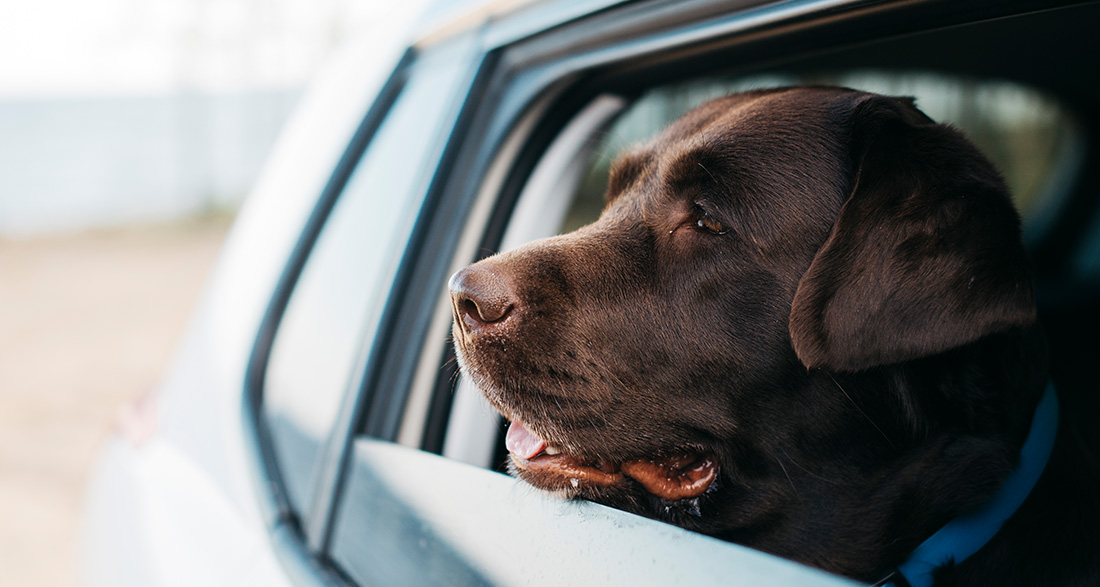Many owners face the challenge of their beloved dogs becoming restless, panting, and sometimes vomiting as soon as they get into the car. If your dog suffers from motion sickness, here you’ll find useful information and tips from a veterinarian to ensure a safe and healthy journey.
- When the Journey Turns Into Agony: How Motion Sickness Affects the Dog
- How to Recognize Motion Sickness in Dogs
- How to Best Prepare for a Journey with Your Dog
- 2 Crucial Steps to Alleviate Motion Sickness
- Step 1 to Reduce Motion Sickness: Diminish Your Dog’s Expectation
- Step 2: Use Calming Treats for Your Dog
When the Journey Turns Into Agony: How Motion Sickness Affects the Dog
Vacations with your dog can often turn into a stressful experience for both you and your furry friend due to motion sickness. Motion sickness, commonly known as travel sickness or in medical terms as kinetosis, is a physical reaction to unusual acceleration, where the perceived signals from the body and those from the eyes conflict with the speed of the car.
For example, the eyes perceive something that does not match the inner ear’s balance system. This leads to a chain reaction of various stimuli in the vomiting center and released neurotransmitters, surpassing your dog’s threshold to vomit. It is not a classic nausea in the sense that the urge to vomit usually serves as a protective reaction after ingesting harmful substances or experiencing stomach overload.
Often, puppies and young dogs experience this issue, with approximately 1 in 6 adult dogs still suffering from kinetosis. However, kinetosis is not solely physical; it can also be learned and later manifest as a psychological condition. Therefore, accurate diagnostics are necessary, as kinetosis can be more complex than it appears. If you suspect this and are unsure, you can have it checked by your veterinarian.
Frequent car journeys can lead to two different learned behaviors. In the better scenario, your dog adapts to the rides and becomes calmer. In the worse scenario, car rides become associated with anticipation anxiety, leading to panic, uncontrolled salivation, potential urination and defecation, and even behavioral disorders.

How to Recognize Motion Sickness in Dogs
Initial signs may include: increasing nervousness, panting, and excessive salivation. As your dog starts feeling more unwell, it may exhibit increased ribcage movement, indicating discomfort in the abdominal area. Eventually, your dog may refuse food at rest stops or vomit in or around the car. Some dogs may experience stress-induced diarrhea after the journey.
How to Best Prepare for a Journey with Your Dog
Preparation is often the key. Whether it’s getting your dog accustomed to car rides from a young age, associating pleasant moments with travels, or managing discomfort before it leaves a negative impression on you and your pet.
If you both can address kinetosis, your dog will feel more comfortable in the car, making travel a more relaxed experience for both of you.
2 Crucial Steps to Alleviate Motion Sickness
Since both the psychological and physical aspects need to be considered, it is advisable to address kinetosis on two fronts. The most effective prevention, and the first approach you should take, is effective training.
Start with small steps to transform the learned physical reaction into a different behavior. Your dog should learn that not every entry into the car leads to a terrible experience with physical impairment.
Firstly, we need to outline the framework and roughly know when your dog shows initial signs of discomfort. With this sequence in mind, you can tailor your training and support your dog.
Step 1 to Reduce Motion Sickness: Diminish Your Dog’s Expectation
Starting outside the stationary car, I recommend initially reducing your pet’s anticipation and lingering with treats nearby.
Once you see progress here, you can begin distributing treats in the stationary car. Once your dog no longer perceives the car as a threatening place and no longer reacts panically when getting in, you can start with very short drives.
If these drives are completed without stress reactions, you should undertake short trips with a rewarding destination.
Examples include:
- A play area
- A lake
- Larger dog parks or fields
This ensures that your dog gets a better perception of car rides and associates them with positive events. Be aware that unlearning instincts is a lengthy endeavor, which is why we always recommend consulting a dog trainer.
Step 2: Use Calming Treats for Your Dog
Despite all precautions, it’s unavoidable that your dog may still feel nauseous after a certain distance of travel. In such cases, you can turn to supplementary food products and give them a try.
Examples of nutritional supplements for travel include:
- A home remedy for mild nausea is a preparation of ginger and melissa. This has a natural, calming effect on the gastrointestinal tract and should be given 30 minutes before the journey and every 3-4 hours during the trip.
- Calming treats for dogs have proven to be effective, promoting a balanced mood and calming effects in stressful situations.
- Another option is the use of Zylkene. However, it’s essential to check in advance if it has a calming effect on your dog. Before application, you should definitely discuss with your veterinarian to determine the best option for you and your furry friend.
- For severe nausea, Maropitant is currently the treatment of choice. It acts as an antagonist to Substance P (the main culprit in vomiting) in the vomiting center, binding to receptors instead of the substance. It should be administered 1-2 hours before the journey and suppresses vomiting for about 12 hours.
However, caution is advised with Maropitant: Although the symptom of vomiting is suppressed, it doesn’t relieve your dog of the feeling of discomfort. Therefore, you should only resort to it if unavoidable and you have to cover a very long distance.
Last but not least, and under strict supervision: Although calming medications are often requested, you should only use them in emergencies. It puts your dog in a twilight state, inhibiting fluid and food intake and altering urine and feces output. The exact dosage is often challenging to adjust and must be determined precisely with your veterinarian. Moreover, the aftereffects can often last one to two days.
Other medications used against nausea include:
- Metoclopramide
- Acepromazine (an additional sedative)
- Ondansetron
These are also not recommended as they frequently lead to side effects.
Conclusion: Introduce Your Dog to Traveling by Car and Support Them

Treating motion sickness in dogs requires a comprehensive approach to manage both psychological and physical symptoms.
An effective prevention approach is to gradually acclimate the dog to car rides, using a training method with small steps and positive reinforcement. Medications can be used as needed in consultation with the veterinarian.
Supplementary food products with ginger and melissa or Zylkene can be helpful for mild nausea. Maropitant is an option for severe nausea but should only be used in emergencies and with caution. Calming medications should be used extremely rarely as they have undesired side effects and require precise dosing. It’s important to always consider your dog’s individual needs to find the best solution for motion sickness.
Our veterinarian authors would like to emphasize that their blogs do not replace veterinary advice. Despite all the exciting information, you should always individually clarify important health decisions for your pet with your veterinarian. Therefore, we also do not assume any liability for damages that may arise from the use of the information presented in this blog. This article makes no claim to completeness. (2024)


